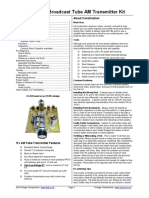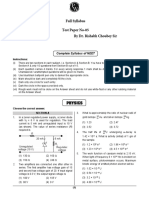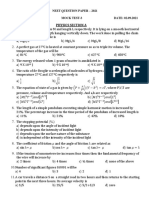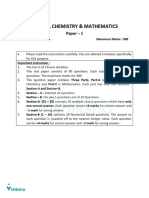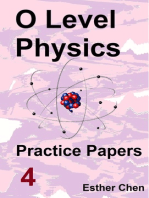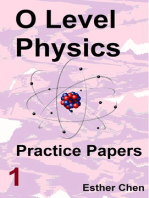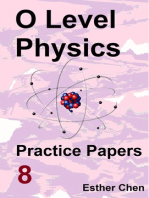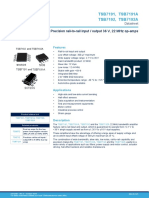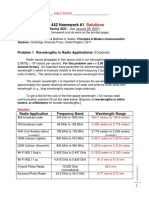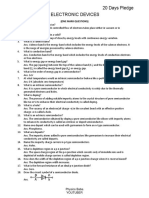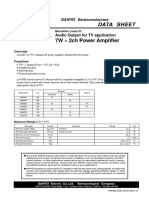Selfstudys Com File (11)
Uploaded by
mail.adwitiyasinha2236Selfstudys Com File (11)
Uploaded by
mail.adwitiyasinha223637
PRACTICE TEST 6
Time : 3 hrs. Max. Marks : 300
PHYSICS length are doubled keeping the area of cross-
section same?
1. The number of significant figures in the
numbers 4.8000 × 104 and 48000.50 are (a) L (b) L (c) 2L (d) 4L
2
respectively
7. A bomb moving with velocity
(a) 5 and 6 (b) 5 and 7 ^ ^ ^
(c) 2 and 7 (d) 2 and 6 (40 i 50 j 25k ) m s −1 explode into two
pieces of mass ratio 1 : 4. After explosion
2. The length of a potentiometer wire is l. A cell
of emf e is balanced at a length l/5 from the the smaller piece moves away with velocity
^ ^ ^
positive end of the wire. If length of the wire (200 i 70 j 15k ) m s–1. The velocity of
is increased by l/2. At what distance will the larger piece after explosion is
same cell give a balance point? (a) 45 ^j 35k^ (b) 45i^ − 35 ^j
2 3 3 4 ^ ^
(a) l (b) l (c) l (d) l (c) 45k^ 35 ^j (d) 35i 45k
15 15 10 10
3. A body A starts from rest with an acceleration 8. A ray of light is incident normally on one
a1. After 2 seconds, another body B starts of the faces of a prism of apex angle 30° and
from rest with an acceleration a2. If they refractive index 2. The angle of deviation of
travel equal distances in the 5th second, after the ray is
the start of A, then the ratio a1 : a2 is equal to (a) 0° (b) 12.5° (c) 15° (d) 22.5°
(a) 5 : 9 (b) 5 : 7 (c) 9 : 5 (d) 9 : 7 9. Particles of masses m, 2m, 3m … nm grams
are placed on the same line at distance l, 2l, 3l
4. A particle of charge q and mass m moves in a
… nl cm from a fixed point. The distance of
circular orbit of radius r with angular speed
centre of mass of the particles from the fixed
w. The ratio of the magnitude of its magnetic
point in centimetre is
moment to that of its angular momentum
depends on (a) (2n + 1)l (b) l
3 n +1
(a) w and q (b) wq and m 2
(c) q and m (d) w and m n(n 1)l 2l
(c) (d)
5. A machine gun is mounted on a 2000 kg car
2 n(n2 + 1)
on a horizontal frictionless surface. At some 10. When one of the slits of Young’s experiment is
instant, the gun fires 10 bullets/second and covered with a transparent sheet of thickness
each of mass 10 g with a velocity of 500 m s–1. 4.8 mm, the central fringe shifts to a position
The acceleration of the car is originally occupied by the 30th bright fringe.
What should be the thickness of the sheet if
(a) 0.025 m s–2 (b) 0.25 m s–2
–2 the central fringe has to shift to the position
(c) 0.50 m s (d) 500 m s–2
occupied by 20th bright fringe?
6. What will happen to the inductance L of a (a) 3.8 mm (b) 1.6 mm
solenoid when the number of turns and the (c) 7.6 mm (d) 3.2 mm
11. A gas expands with temperature according to What will be the temperature T of the
the relation V = KT2/3. Calculate work done junction?
when the temperature changes by 60 K? 200 100
(a) 10R (b) 30R (c) 40R (d) 20R (a) °C (b) °C
3 3
12. The electric field (in N C–1) in an 50
electromagnetic wave is given by (c) 75°C (d) °C
3
x 18. The mass of deuteron (1H2) nucleus is
E 50sinω t − .
c 2.014102 u. If the masses of proton and
The energy stored in a cylinder of cross- neutron are 1.007825 u and 1.008665 u
section 10 cm2 and length 100 cm along the respectively, nucleus the binding energy per
nucleon of 1H2 nucleus is
x-axis will be
(a) 2.2 MeV (b) 1.1 MeV
(a) 5.5 × 60–12 J (b) 1.1 × 10–11 J
–11 (c) 0.5 MeV (d) 0.25 MeV
(c) 2.2 × 10 J (d) 1.65 × 10–11 J
19. An electric dipole of length 1 cm is placed
13. A liquid X of density 3.36 g cm–3 is poured in with the axis making an angle of 30° with
a U-tube, which contains Hg. an electric field of strength 104 N C – 1. If
Another liquid Y is it experiences a torque of 10 2 N m, the
Y X potential energy of the dipole is
poured in left arm 8 cm 10 cm
with height 8 cm, (a) 0.245 J (b) 2.45 J
upper levels of X (c) 0.0245 J (d) 24.5 J
and Y are same. 20. A rod is oscillating from a support, freely. The
What is the density of Y? period is
(a) 0.8 g cm–3 (b) 1.2 g cm–3 (a) T 2π l
–3
(c) 1.4 g cm (d) 1.6 g cm–3 g
14. A common emitter amplifier has a voltage
gain of 50, an input impedance of 100 W and (b) T 2l
2π
an output impedance of 200 W. The power g
gain of the amplifier is
(a) 500 (b) 1000 (c) 1250 (d) 100 l
(c) T 2 π
3g
15. The Poisson’s ratio of a material is 0.4. If a
force is applied to a wire of this material, 2l
(d) T 2 π
there is a decrease of cross-sectional area by 3g
2%. The percentage increase in its length is
(a) 3% (b) 2.5% (c) 1% (d) 0.5% NUMERICAL VALUE TYPE
16. A signal wave of frequency 12 kHz is 21. A parallel plate capacitor is maintained at a
modulated with a carrier wave of frequency certain potential difference. When a 3 mm thick
2.51 MHz. The upper and lower side band slab is introduced between the plates, in order
frequencies are respectively to maintain the same potential difference, the
(a) 2512 kHz and 2508 kHz distance between the plates is increased by
(b) 2522 kHz and 2488 kHz 2.4 mm. The dielectric constant of the slab is ____.
(c) 2502 kHz and 2498 kHz 22. A silver sphere of radius 1 cm and work
(d) 2522 kHz and 2498 kHz function 4.7 eV is suspended from an
17. Three rods of same dimensions have thermal insulating thread in free-space. It is under
conductivities 3K, 2K and K respectively. continuous illumination of light of wavelength
They are arranged as shown below 200 nm. As photoelectrons are emitted, the
50°C sphere gets charged and acquires a potential.
3K T 2K The maximum number of photoelectrons
100°C
K emitted from the sphere is A × 10Z (where
0°C 1 < A < 10). The value of Z is ______.
23. The activity of a freshly prepared radioactive (i) Pure solvent → separated solvent
sample is 1010 disintegrations per second, molecules, DH1
whose mean life is 109 s. The mass of an atom (ii) Pure solute → separated solute molecules,
of this radioisotope is 10–25 kg. The mass of DH2
the radioactive sample is ______ mg. (iii) Separated solvent and solute molecules →
solution, DH3
24. The period of revolution of planet A around the
Solution so formed will be ideal if
sun is 8 times that of B. The distance of A from
(a) DHsolution = DH1 + DH2 – DH3
the sun is ______ times that of B from the sun.
(b) DHsolution = DH1 – DH2 – DH3
25. In a car race sound signals emitted by the (c) DHsolution = DH3 – DH1 – DH2
two cars are detected by the detector on the (d) DHsolution = DH1 + DH2 + DH3
straight track at the end point of the race.
Frequency observed are 330 Hz and 360 Hz 30. During the extraction of Cu in the blast
and the original frequency is 300 Hz of both furnace at the roasting step,
cars. Race ends with the separation of 100 m (a) Cu2S gets converted to Cu2O if
between the cars. Assume both cars move temperature is below 800°C
with constant velocity and velocity of sound (b) Cu2S gets converted to Cu2O if
is 330 m s–1. The time taken by winning car is temperature is above 800°C
______ s. (c) FeS remains unaffected and gets
converted to FeO only at temperature
CHEMISTRY above 1000°C
(d) FeSiO3 is formed and removed.
26. Aniline is treated with bromine water to
give an organic compound ‘X’ which when 31. If we consider that 1/6, in place of 1/12, mass
treated with NaNO2 and HCl at 0°C gives of carbon atom is taken to be the relative
a water soluble compound ‘Y’. Compound atomic mass unit, the mass of one mole of a
substance will
‘Y’ on treatment with Cu2Cl2 and HCl gives
(a) decrease to half (b) increase two fold
compound ‘Z’. Compound ‘Z’ is (c) remain unchanged
(a) o-bromochlorobenzene (d) be a function of the molecular mass of
(b) p-bromochlorobenzene the substance.
(c) 2, 4, 6-tribromophenol
(d) 2, 4, 6-tribromochlorobenzene. 32. Match the polymers given in column I with
their chemical names given in column II.
27. Temporary hardness and permanent hardness Column I Column II
in water can be removed respectively by P. Nylon 6 1. Polyvinyl chloride
addition of Q. PVC 2. Polyacrylonitrile
(a) CaO, CaCO3 (b) CaO, Na2CO3 R. Acrilan 3. Polycaprolactum
(c) Na2CO3, CaO (d) NaHCO3, CaCl2 S. Natural rubber 4. cis-Polyisoprene
(a) P–1, Q–2, R–3, S–4
28. According to adsorption theory of catalysis, (b) P–4, Q–3, R–1, S–2
the speed of the reaction increases because (c) P–3, Q–1, R–4, S–2
(a) concentration of the reactant molecules (d) P–3, Q–1, R–2, S–4
at active centres of the catalyst becomes
high due to adsorption 33. Consider the following equilibrium in a
closed container, N2O4(g) 2NO2(g).
(b) in the process of adsorption, the
At a fixed temperature, the volume of the reaction
activation energy of molecules becomes
mixture is halved. For this change, which of
large the following statements holds true regarding
(c) adsorption produces heat which increases the equilibrium constant (Kp) and degree of
the speed of the reaction dissociation (a)?
(d) adsorption lowers the activation energy (a) Neither Kp nor a changes.
of the reaction. (b) Both Kp and a change.
29. Formation of a solution from two components (c) Kp changes but a does not.
can be considered as (d) Kp does not change but a changes
34. The detergent which is used as a germicide is 40. In kinetic study of a chemical reaction, slopes
(a) sodium lauryl sulphate are drawn at different times in the plot of
(b) cetyltrimethylammonium chloride concentration of reactants versus time. The
(c) lauryl alcohol ethoxylate magnitude of slopes with increase of time
(d) sodium-2-dodecylbenzenesulphonate. (a) remains unchanged
35. Which of the following is an anti-aromatic (b) increases
compound? (c) decreases
CH3
(d) increases and decreases periodically
(a) (b)
:
N 41. Phenol is converted into bakelite by heating
H it with formaldehyde in the presence of an
alkali or an acid. Which statement is true
(c) (d)
regarding this reaction?
36. A 1.0 M solution with respect to each of (a) The electrophile in both cases is CH2 O.
metal halides AX3, BX2, CX3 and DX2 is (b) The electrophile in both cases is
+
electrolysed using platinum electrodes. If CH2 OH.
E °3 1.50 V, E ° 2 + = 0.34 V, (c) The electrophile is CH2 O in the
A /A B /B +
E 3 −0.74 V, E 2 + −2.37 V, presence of an alkali and CH2 OH in
C /C D /D
the correct sequence in which the various the presence of an acid.
metals are deposited at the cathode, is (d) It is a nucleophilic substitution reaction.
(a) A, B, C, D (b) D, C, B, A
(c) A, B, C (d) C, B, A 42. The correct order of bond order values among
the following species is
37. Schottky defect occurs mainly in electrovalent
(i) NO– (ii) NO+
compounds where
(a) positive ions and negative ions are of (iii) NO (iv) NO2+
different size (v) NO2–
(b) positive ions and negative ions are of (a) (i) < (iv) < (iii) < (ii) < (v)
same size (b) (iv) = (ii) < (i) < (v) < (iii)
(c) positive ions are small and negative ions (c) (v) < (i) < (iv) = (iii) < (ii)
are big (d) (ii) < (iii) < (iv) < (i) < (v)
(d) positive ions are big and negative ions are
small. 43. An organic compound ‘X’ on treatment with
pyridiniumchlorochromate in dichloromethane
38. The correct IUPAC name of the compound gives compound ‘Y’. Compound ‘Y’ reacts with
[Cr(NH3)5(NCS)] [ZnCl4], is
I2 and alkali to form triiodomethane. The
(a) pentaammineisothiocyanatochromium
(III) tetrachloridozincate(II) compound ‘X’ is
(b) pentaammineisothiocyanatozinc (a) C2H5OH (b) CH3CHO
chloridochromate(III) (c) CH3COCH3 (d) CH3COOH
(c) pentaammineisothiocyanatochromate(II) 44. An element X belongs to fourth period and
(d) isothiocyanatopentaamminechromium fifteenth group of the periodic table. Which
(II) zincchlorido(IV).
of the following statements is true?
39. Consider the given (a) It has a completely filled s-orbital and a
curve, the correct y partially filled d-orbital.
relationship among (b) It has completely filled s-and p-orbitals
T1 and T2 is N
N and a partially filled d-orbital.
(a) T1 > T2 T2
(c) It has completely filled s-and p-orbitals
T1
(b) T2 > T1 z and a half-filled d-orbital.
Speed
(c) T1 = T2 (d) It has a half-filled p-orbital and
(d) can’t be predicted. completely filled s-and d-orbitals.
45. The standard reduction potential values
of three metallic cations, X, Y and Z are log e 2 + x − x 2n sin x
53. Let f (x) = lim , then
0.52, – 3.03 and –1.18 V respectively. The n 1 + x 2n
order of reducing power of the corresponding (a) f(x) is continuous at x = 1
metals is
(a) Y > Z > X (b) X > Y > Z (b) lim f x = log e 3
(c) Z > Y > X (d) Z > X > Y x 1
(c) lim f x − sin1
NUMERICAL VALUE TYPE x 1
46. Among the following, the total number (d) lim f x ) does not exist
of alkyl halides that would react by SN1 x 1
mechanism is ______ .
CH3Br, CH3CH2Br, CH3CH2CH2I, 3 5 7π
54. cos cos cos cos is equal to
(CH3)3CBr, BrCH2CH CH2, C6H5CH2Br, 8 8 8 8
(CH3)3CCH2Br, C6H5 CHBr CH3,
CH3CH CHCH2Cl 1 1− 2
(a) (b)
2 2 2
47. 2 moles of a perfect gas at 27°C is compressed
reversibly and isothermally from a pressure of 1 1+ 2
1.01 × 105 Nm–2 to 5.05 × 106 Nm–2. The free (c) (d)
8 2 2
energy change is x × 104 joule. The value of x
is ______ . 55. If S.D. of a variate x is s then the S.D. of
48. Titanium shows magnetic moment of 1.73 B.M. ax + b
( a, b, p R) is
in its compound. The oxidation number of Ti p
in the compound is ______ .
a a p p
49. In the compound beryl, number of oxygen (a) (b) (c) x (d) σ
atoms shared by one silicate tetrahedron is p x p x a a x
______ . 56. In how many ways n books can be arranged
50. In a compound C, H and N are present in in a row so that two specified books are not
9 : 1 : 3.5 by weight. If molecular weight of together?
the compound is 108, the number of N atoms (a) n! – (n – 2)! (b) (n – 1)! (n – 2)
present in the molecular formula will be
(c) n! – 2(n – 1) (d) (n – 2)n!
______ .
57. If a, b, c are respectively the pth, qth, rth terms
.MATHEMATICS
a p 1
51. Let g(x) = 1 + x – [x], [x] is the greatest integer of an A.P., then b q 1 =
not greater than x. c r 1
1, x < 0
(a) 1 (b) –1 (c) 0 (d) pqr
If f (x) 0, x = 0 , then for all x, f(g(x))
1, x > 0 58. The angle between the lines 3x = 6y = 2z and
3x + 2y + z – 5 = 0 = x + y – 2z – 3 is
equals
(a) x (b) 1 (c) f(x) (d) g(x) (a) (b) (c) (d)
x 6 3 4 2
2
52. dx = 1/3
1/2
cos x cos x
1 − 4x 59. lim =
1 x →0 sin2 x
(a) (log2)sin–1 2x + C (b) sin −1 2 x C
2 1 1 1 1
1 (a) (b) (c) (d)
(c) sin −1 2 x C (d) 2log2 sin–12x + C 3 6 2 12
log 2
x2 y2 67. A is one of 6 horses entered for a race, and
60. Let y 4x 2 and = 1 intersect iff is to be ridden by one of two jockeys B and
2 16
a
C. It is 2 to 1 that B rides A, in which case all
1 1 the horses are equally likely to win. If C rides
(a) a (b) a <
2 2 A, his chances of winning is tripled. What are
1 the odds against winning of A?
(c) a (d) none of these (a) 5 : 13 (b) 5 : 18
2
(c) 13 : 5 (d) none of these
61. If 1, log 9(31 x 2), log 3(4.3x − 1) are in A.P. 68. In the expansion of (1 + x + x3 + x4)10, the
then x equals coefficient of x4 is
(a) log34 (b) 1 – log34 (a) 40C4 (b) 10C4 (c) 210 (d) 310
(c) 1 – log43 (d) log43 69. The solution for x of the equation
n n x
62. If P(n) : “49 + 16 + k is divisible by 64 for all dt
is
n ∈ N” is true, then the least negative integral 2 2
2 t t −1
value of k is
(a) – 1 (b) – 2 (c) – 3 (d) – 4 3
(a) (b) 2 2 (c) − 2 (d) p
2
dy
63. If sin x + y cos x = x sin x, then (y – 1) 70. If z1, z2 and z3 are complex numbers such that
dx
sin x = 1 1 1
(a) c – x sin x (b) c + x cos x |z1| = |z2| = |z3| = + 1 , then
z1 z2 z3
(c) c – x cos x (d) c + x sin x
|z1 + z2 + z3| is
64. The image of the line 2x – y = 1 in the line
x + y = 0 is (a) equal to 1
(b) less than 1
1
(a) x 2y (b) x – 2y = 1 (c) greater than 3
3
(d) equal to 3
2 1
(c) x 3y (d) 2x y =
3 3 NUMERICAL VALUE TYPE
x x x
C1 C2 C3
71. If 3x 2 7x 30 2x 2 7 x − 5 = x + 5 ,
y y y
65. The determinant C1 C2 C3 = then x is equal to ______.
z z z
C1 C2 C3 72. The projection of a 3iɵ ɵj + 5kɵ on
1 b 2iɵ 3jɵ + kɵ is ______.
(a) xyz(x y)(y z)(z + x)
3 56 ∞ 2k is
1
73. The value of tan −1 4
(b) xyz(x y z)(y z x) π 2
2 k +k
k =1
4 ______.
1 74. If the foot of perpendicular from the point
(c) xyz(x y)(y z)(z − x)
12 (1, –5, –10) to the plane x – y + z = 5 is the
(d) none of these point (a, b, c), then | a + b + c | is ______.
66. If y = a ln x + bx2 + x has its extreme values at tan x tan ytan z
75. If and x + y + z = p,
x = –1, 2 then a + b = 2 3 5
3 38
(a) 2 (b) (c) 1 (d) 1 tan2x + tan2y + tan2z , then K = ______.
2 2 K
Hints and Explanations
1. (b) : All the non-zero digits are significant. 4. (c) : Magnetic moment, M = IA
The trailing zero (s) in a number with decimal qv ω 2 1
M r2 q r = q r
2
point are significant. Power of 10 is irrelevant for 2 r 2 2
the determination of significant figures. Hence, Angular momentum,
4.8000 × 104 has 5 significant figures. L = mvr = m(wr)r = mwr2
All the non-zero digits are significant. All the 1
qωr 2
zeros between two non-zero digits are significant, M 2 1 q
=
no matter where the decimal point is. The trailing L mωr 2 2 m
zero(s) in a number with decimal point are 5. (a) : Here, M = 2000 kg, m = 10 g = 0.01 kg
significant. Hence, 48000.50 has 7 significant Force on car = rate of change of momentum of
figures. bullets
F = nmv = 10 × 0.01 × 500 = 50 N
2. (c) : In first case, potential gradient, K 0
F 50
l
where e0 is the emf of the battery in potentiometer a = 0.025 ms −2
M 2000
circuit. As per question 6. (c) : In case of a solenoid as B = m0nI,
Kl 0 l ε0 f = B(nlS) = m0n2lSI and hence
=
5 l 5 5
In second case, length of potentiometer wire φ 2 N2 N
L 0n lS µ0 S as n =
l 3l I l l
l = When N and l are doubled, then
2 2
0 2ε 0 (2N )2 N2
Potential gradient, K L′ 0 S 2 0 S 2L
3l / 2 3l 2l l
If l′ is the new balancing length, then i.e., inductance of the solenoid will be doubled.
0 2ε 0 3 7. (a) : Let the mass of the unexploded bomb be
l or l = l
5 3l 10 5m.
3. (a) : Time taken by body A, t1 = 5 s It explodes into the two pieces of masses m and
Acceleration of body A = a1 4m respectively.
Time taken by body B, t2 = 5 – 2 = 3 s Initial momentum of the unexploded bomb
^ ^ ^
Acceleration of body B = a2 5m(40 i 50 j − 25k)
Distance covered by first body in 5th second after After explosion, momentum of the smaller piece
its start, ^ ^ ^
mv1 m(200 i 70 j + 15 k)
a a 9
S5 u 1 (2t1 −1) 0 1 (2 5 1) = a1 and momentum of the larger piece = 4mv2
2 2 2
where v1 and v2 are the velocities of the two
Distance covered by the second body in the 3rd
pieces respectively.
second after its start,
According to law of conservation of momentum,
a a 5
S3 u 2 (2t 2 −1) 0 2 (2 3 1) = a2 we get
2 2 2 ^ ^ ^ ^ ^ ^
Since S5 = S3 5m(40 i 50 j 25 k) m(200 i 70 j 15 k) 4mv2
^ ^ ^ ^ ^ ^
9 5 4mv2 5m(40 i 50 j 25 k) m(200 i + 70 j + 15 k )
a = a 1
2 1 2 2 v2
^ ^ ^
(180 j 140 k) 45 j 35k
^
or a1 : a2 = 5 : 9 4
8. (c) : For normal incidence, 12. (b) : Energy contained in a cylinder
i = 0°, r1 = 0° U = average energy density × volume
As r1 + r2 = A 1
E 2 × Al
\ r2 = A – r1 = 30° 2 0 0
sin e 1
As (8.85 10 12 ) (50)2 (10 10 4 ) × 1
sin r2 2
sin e = µ sin r2 = 1.1 × 10–11 J
1 Y X
2 sin 30 = 13. (a) : As shown 8 cm
10 cm
2 in adjacent figure, in 2 cm
P P
e = 45° the two arms of a tube Hg
d = i + e – A = 0° + 45° – 30° = 15°. pressure remains same
9. (a) : on surface PP′.
Hence,
8 × rY × g + 2 × rHg × g = 10 × rX × g
\ 8rY + 2 × 13.6 = 10 × 3.36
33.6 27.2
or Y = 0.8 g cm 3
8
The distance of centre of mass of given configuration 14. (c) : AC power gain is ratio of change in
of the particles from the fixed point O is output power to the change in input power. AC
m x m2 x2 m3 x3 ... mn xn power gain
XCM = 1 1
m1 m2 m3 ... + mn Change in output power Vo × ∆Ic
(m)(l ) (2m)(2l ) (3m)(3l ) ... (nm)(nl ) Change in input power Vi × ∆Ib
XCM =
m 2m 3m ... + nm ∆Vo ∆Ic
ml [12 22 32 ... + n2 ] ∆V ∆I AV × AC
i b
m [1 2 3 ... + n]
where AV is voltage gain and (b)AC is AC current
(l )(n)(n 1)(2n + 1) gain.
6 (2n +1)l Ro
cm
AC × resistance gain
= = Also, AV
(n)(n + 1) 3 Ri
2
nD Given, AV = 50, Ro = 200 W, Ri = 100 W
10. (d) : ∆x = D(µ −1)t . Also ∆x . 200
d d Hence, 50 β AC ×
100
D( 1)t nD
or (m – 1)t = nl \ bAC = 25
=
d d Now, AC power gain = Ac × bAC = 50 × 25 = 1250
t1 n1 n2t1 ∆d / d
or t2 = 15. (b) : Poisson’s ratio, σ =
t2 n2 n1 l /l
d2
or t 2
20 4.8
= 3.2 mm. Area, A r2 = π (Q d = 2r )
4
30
2 d∆d π
RT ∆A = d∆d
11. (c) : dW PdV dV ...(i) 4 2
V
2 d
As V KT 2 / 3 dV =K T −1/ 3 dT A
π ∆d
d
2 3 2 =2
dV K T −1/ 3 dT 2 dT A d 2 d
3 = π
V KT 2 / 3 3 T 4
T2
dV T2 2 dT ∆A
From (i), W RT = ∫ RT Given: 100 2%
V 3 T A
T1 T 1
d ∆d ...(i)
2 2 2 2 100 or 100 = 1%
W R (T2 T1 ) R 60 40R d d
3 3
∆d / d d ∆l 20. (d) : The torque = Ia
0.4 or 2
Given: 0.4
The restoring torque I d lθ
∆l / l d l −mg
l 1 ∆d dt 2 2
100 × 100
l 0. 4 d d2 mg l / 2 3g d2
θ ⇒
2
2 ,
= 2.5 × 1% = 2.5% (Using (i)) dt 2 ml / 3 2l dt 2
16. (d) : Here, us = 12 kHz, where, ω = 3g /2l
uc = 2.51 MHz = 2510 kHz
The upper side band frequency 2π 2l
T 2π
= 2510 + 12 = 2522 kHz 3g
The lower side band frequency 21. (5.0): The capacitance of a parallel plate
= 2510 – 12 = 2498 kHz capacitor in air is given by
17. (a) : Let L and A be length and area of cross- 0A
C
section of each rod. d
50°C By introducing a slab of thickness t, the new
2
H
100°C
3K T 2K capacitance C′ becomes
K
H1 H 0A
3 0°C C =
At steady state, 1
d t 1 −
H1 = H2 + H3 K
(100 − T )(3K )A (T 50)2KA (T − 0)KA The charge (Q = CV) remains the same in both
+ the cases.
L L L
3(100 – T) = 2(T – 50) + T Hence,
300 – 3T = 2T – 100 + T 1
0A = 0A
or d d t 1 −
6T = 400 K
d 1
400 200 d t 1 −
or T = = °C K
6 3
18. (b) : Here, mp = 1.007825 u, mn = 1.008665 u Here, d′ = d + 2.4 × 10–3 m, t = 3 mm = 3 × 10–3 m
mass of 1H2 nucleus, mN(1H2) = 2.014102 u Substituting these values, we get
The deuteron nucleus contains one proton and 1
d d (2.4 10 3 ) 3 10−3 1 −
one neutron. K
Therefore, mass of nucleons constituting deuteron, 1
mp + mn = 1.007825 + 1.008665 = 2.01649 u or (2.4 10 3 ) 3 10−3 1 −
K
Mass defect, DM = (mp + mn) – mN(1H2) Solving it, we get K = 5
= 2.01649 – 2.014102 = 0.002388 u
= 0.002388 × 931.5 MeV/c2 22. (7.0) : Here, radius of sphere R = 1 cm = 1 × 10–2 m
= 2.224 MeV/c2 Work function, W = 4.7 eV
Binding energy, Eb = DMc2 = 2.224 MeV Energy of incident radiation
Binding energy per nucleon hc 1240 eV nm
Eb 2.224 = (Take hc = 1240 eV nm)
= 1.112 MeV λ 200 nm
A 2 = 6.2 eV
19. (d) : Here, t = pE sin q According to Einstein’s photoelectric equation
p
10 2 p 104 sin 30 104 hc
2 W eVs
20 2
p 2 2 10−3 6.2 eV = 4.7 eV + eVs R
e–
104
Vs = 1.5 V
P.E. = pEcos q
3 The sphere will stop emitting photoelectrons,
2 2 10−3 104 cos 30 20 2 × when the potential on its surface becomes equal
2
10 6 10 × 2.45 J = 24.5 J to 1.5 V.
1 Q 100 100
= 1. 5 t =4s
4 ε0 R v2 v1 55 30
1 Ne
1. 5 26. (d) :
4 ε0 R NH2 NH2
where N = Number of photoelectrons emitted, Br Br
Br2/H2O
e = charge of each electron.
NaNO2/
1. 5 × R 1.5 1 × 10−2 Aniline 0–5°C
N Br HCl
1 9 −19
× e 9 10 1.6 × 10 (X) +
4 ε0 –
Cl N2Cl
15 1 5 Br Br Br Br
N 108 108 Cu2Cl2
16 9 48
HCl
50
N 107 1.04 107 \ Z = 7
48 Br Br
(Z) (Y)
23. (1.0): Activity, A = lN
2, 4, 6-Tribromo
1 1
A N As = chlorobenzene
τ τ 27. (b) : Temporary hardness is due to dissolved
where t is the mean life time.
N = At = (1010 decay/s)(109 s) = 1019 atoms HCO3– of Ca2+ and Mg2+.
Mass of the sample, m = N × (mass of 1 atom) CaO + H2O Ca(OH)2
Ca(HCO3)2 + Ca(OH)2 2CaCO3↓ + 2H2O
= 1019 × 10–25 kg = 10–6 kg = 1 mg
Permanent hardness is due to dissolved Cl– and
24. (4) : According to Kepler’s third law SO42– of Ca2+ and Mg2+.
T2 ∝ r3 CaCl2 + Na2CO3 CaCO3↓ + 2NaCl
TA2 rA3 CaSO4 + Na2CO3 CaCO3↓ + Na2SO4
= .
TB2 rB3 28. (a) : The increased concentration of the
2 /3 reactants on the surface influences the rate of reaction.
rA TA
or T (8)2/3 = 4 or rA = 4rB 29. (d) : DHsolution is the summation of all the
rB B
heats involved in the formation of solution.
25. (4.0): Let the velocities of car 1 and car 2 be
v1 m s–1 and v2 m s–1. 30. (b) : (b) is correct as very high energy is
required for the conversion of CuS to CuO. It
\ Apparent frequencies of sound emitted by
follows (a) is wrong.
car 1 and car 2 as detected at end point are
(c) is wrong as FeS gets converted to FeO even at
0v υ0 v low temperature below 800°C.
1 and 2
v v1 v − v2 (d) is wrong as FeSiO3 is formed at 1400°C during
300 × 330 smelting and not during roasting.
330 or v1 30 m s −1
330 v1 31. (a) : 1 atomic mass unit on the scale of 1/6 of
C–12 = 2 amu on the scale of 1/12 of C–12.
300 × 330
and 360 or v2 55 m s −1 Now, atomic mass of an element
330 v2 Mass of one atom of the element
v2 t =
1
v1 t 1 amu (Here on the scale off of C -12)
2 6
Mass of one atom of the element
A 100 m
B =
1
2 amu (Here on the scale off of C -12)
The distance between both the cars just when the 12
2nd car reaches point B(as shown in figure) is \ Numerically the mass of a substance will
100 m = v2t – v1t become half of the normal scale.
32. (d) 1
Bond order = (8 − 3) = 2.5
33. (d) : Kp is constant at constant temperature. 2
As volume is halved, pressure will be doubled. (iv) NO2+ :
Hence, equilibrium will shift in the backward 1
Bond order = (7 − 2) = 2.5
direction, i.e., degree of dissociation decreases. 2
(ii) NO+ :
34. (b)
1
35. (c) : Planar conjugated cyclic compounds
Bond order = (8 − 2) = 3.0
2
containing 4np electrons are anti-aromatic, e.g., (i) NO– :
cyclooctatetraene (8p e–s). 1
Bond order = (8 − 4) = 2.0
36. (c) : The cations will be deposited as metals in 2
the sequence of decreasing reduction potentials. (v) NO2– :
Cations having E° value < – 0.83 V (reduction 1
Bond order = (8 − 5) = 1.5
potential of water) will not be deposited from 2
aqueous solutions. Hence, the correct order is
NO2– < NO– < NO2+ = NO < NO+
37. (b) 38. (a)
(v) (i) (iv) (iii) (ii)
39. (b) : With rise of temperature, the most PCC
probable speed increases. 43. (a) : CH3CH2OH
CH2Cl 2 CH3CHO
‘X’ ‘Y’
40. (c) : As time increases slope will decrease.
CHI3↓
I2 /NaOH
41. (c) : Condensation of phenol with
formaldehyde is an electrophilic substitution 44. (d) : Element X belongs to fourth period and
reaction. Base converts phenol into phenoxide fifteenth group.
ion which being more reactive, reacts easily with Period 1 2 3 4
CH2 O (a weak electrophile). Group 15 Nil N(7) P(15) As(33)
Let us configure As(33). Now,
As(33) → 1s2 2s2 2p6 3s2 3p6 3d10 4s2 4p3
So, s and d-orbitals are fully-filled and p-orbital is
half-filled.
45. (a) : More negative or lower the reduction
potential, more is the reducing property. Thus, the
order of reducing power is Y > Z > X.
46. (6) : Alkyl halides that can form 3°, allylic or
In presence of an acid, CH2 O (a weak benzylic carbocations react by SN1 mechanism.
+ These are (CH3)3CBr, BrCH2CH CH2,
electrophile) is protonated to CH2 OH (a strong
C6H5CH2Br, (CH3)3CCH2Br, C6H5CHBrCH3 and
electrophile) which easily reacts with phenol (a
CH3CH CHCH2Cl.
weak nucleophile).
47. (2) : For reversible process
P
Wrev 2.303 nRT log10 1
P2
1.01 × 105
2.303 2 8.314 300 log10
5.05 × 106
= + 1.9518 × 104 joule
Since, Wrev is a measure of free energy change
\ – DG = –Wrev = – Wmax
or DG = 1.9518 × 104 joule @ 2 × 104 joule
42. (c) : (iii) NO(15) : KK s2s2 s*2s2 s2pz2 p2px2 48. (3) : meff value of 1.73 B.M. corresponds to one
= p2py2, p*2p1x unpaired electron. Ti3+ = 3d1 (Ti = [Ar] 3d2 4s2).
49. (2) : Beryl is a cyclic silicate. lim f x sin1; lim f x ) = log3.
The formula of Beryl is Be3Al2(SiO3)6. x 1 x →1−
Every SiO44– unit shares two O atoms. The
54. (c) : cos 3 5 7π
structure is coscos ⋅ cos
8 8 8 8
π
cos sin − sin − cos
8 8 8 8
2
1 1 2π 1 1 1
2 sin cos sin = .
4 8 8 4 4 4 2 8
SiO44– is sharing two O atoms. ax b ax + b
55. (b) : Let y y
p p
50. (2) : C H N
1 a2
Weight ratio : 9 : 1 : 3.5 Now, y y a(x − x ) ⇒ (y y)2 (x − x )2
p p2
Molar ratio : 9 : 1 : 3.5
1 a2 1
12 1 14 ( y − y )2 ∑ (x − x)2
3 1 1 n p2 n
= : :
4 1 4 a a
S.D. of y = S.D. of x σ
Simplest ratio : 3 : 4 : 1 p p x
Empirical formula = C3H4N
56. (b) : Total number of arrangements of n
(C3H4N)n = 108
books = n!.
(12 × 3 + 1 × 4 + 14)n = 108
If two specified books always together then
54 n = 108 ⇒ n = 108/54 = 2
number of ways = (n – 1)! × 2
Molecular formula = C6H8N2
Hence required number of ways = n! – (n – 1)! × 2
51. (b) : The given functions are = n(n – 1)! – (n – 1)! × 2 = (n – 1)! (n – 2).
1, x < 0 57. (c) : Let first term = A and common
g (x) 1 x [x] and f (x) = 0, x = 0 difference = D
1, x > 0 \ a = A + (p – 1)D, b = A + (q – 1)D,
c = A + (r – 1)D
We see that g(x) 1 x [x] 1 (x [x]) a p 1 A ( p − 1)D p 1
1 {x} 1 (Q 0 {x} < 1)
b q 1 = A (q − 1)D q 1
\ f(g(x)) = 1 for all x
c r 1 A (r − 1)D r 1
2x
52. (c) : Let I = ∫ dx Operate C1 → C1 – DC2 + DC3
1 − 4x
A p 1 1 p 1
Put 2x = t ⇒ 2x log 2 dx = dt
1 dt 1 t A q 1 A 1 q 1 =0
I= sin −1 C
log 2 1 − t 2 log 2 1 A r 1 1 r 1
1 1 1 1
sin −1 2 x + C 58. (d) : The d.r’s of the first line are , , ...(i)
log 2 3 6 2
The second line is along the vector
53. (c) : For |x| < 1, x2n → 0 as n → ∞
ɵi ɵj ɵ
k
1
| x | 1, 2n 0 as n ∞
x 3 2 1 5ɵi 7ɵj + ɵ
k
log e 2 + x ) , |x|<1 1 1 −2
x −2n log e 2 + x − sin x The d.r’s are – 5, 7, 1 ...(ii)
f x = lim − sin x, if |x|>1 5 7 1
n ∞ x −2n + 1
From (i) and (ii) ⇒ 0.
1 log 2 x − sin x ) , |x|=1
3 6 2
2 e \ The lines are perpendicular.
59. (d) : Put cos x = t x(x 1) x(x 1)(x − 2)
1 1 x
2 6
(cos x)1/3 (cos x)1/2 t3 −t2 y( y 1)( y − 2)
⇒ lim lim 65. (c) : y
y( y 1)
x 0 sin2 x t 1 1− t2
2 6
2 −1 z(z 1) z(z 1)(z − 2))
1 3 1 2 1 1 z
t − t − 1 2 6
= lim 3 2 =3 2= (By L.H. Rule)
t →1 2t 2 12 1 x x2
xyz
60. (a) : y = 4x2 ⇒ x 2 =
1
y = 1 y y2
4 12
1 z z2
x2 y2 yy2
\ 1 becomes 1 Use R1 → R1 – R2 and R2 → R2 – R3 and expanding
a2 16 4a2 16 along R3, we have,
⇒ 4y – a2y2 = 16a2 ⇒ a2y2 – 4y + 16a2 = 0 xyz
⇒ D ≥ 0 for intersection of two curves (x y)( y z)(z − x)
12
⇒ 16 – 4a2 (16a2) ≥ 0 ⇒ 1 – 4a4 ≥ 0 a
1 1 66. (b) : y′ = + 2bx + 1, y′(–1) = 0, y′(2) = 0
⇒ (2a2 )2 ≤ 1 ⇒ | 2a | ≤ 1 ⇒ − ≤a≤ x a
2 2 ⇒ –a – 2b + 1 = 0, + 4b + 1 = 0
2
61. (b) : The given numbers are in A.P. 1 3
⇒ a=2,b= ⇒a +b= .
\ 2 log 9(31 x + 2) = log 3(4 3x 1) + 1 2 2
⇒ 2 log 2 (31 x + 2) = log 3(4 3x 1) + log 3 3 67. (c) : Let us define the events as
3 E1 : Jockey B rides horse A
2
⇒ log (31 x + 2) = log 3[3(4 3x 1)] E2 : Jockey C rides horse A
2 3 E : The horse A wins
⇒ 31−x + 2 = 3(4 3x − 1) \ P(E1)
2
[Since odds in favour of E1 are 2 : 1]
3 3
⇒ 2 12 y 3, where y 3x 1
y and P(E E1) =
6
⇒ 12 y 2 5 y 3 = 0 2 1
Again P(E2 ) 1 P(E1) 1 =
1 3 1 3 3 3
y or 3x or 3x = 1
3 4 3 4 and P(E E2 ) 3P(E E1) =
x log 3 (3 / 4) x = 1 − log 3 4 . 2
Now, the required probability = P(E)
62. (a) : For n = 1, P(1) : 65 + k is divisible by 64. = P(E1 ∩ E) + P(E2 ∩ E)
\ k, should be –1 since, 65 – 1 = 64 is divisible = P(E1) P(E|E1) + P(E2) P(E|E2)
by 64. 2 1 1 1 5
=
d 3 6 3 2 18
63. (c) : (sin x. y) = x sin x Therefore the odds against winning of A are 13 : 5.
dx
\ y sin x = ∫ x sin x dx = –x cos x + sin x + c 68. (d) : (1 x x 3 x 4 )10 (1 x)10 (1 x 3 )10
⇒ (y – 1) sin x = c – x cos x. (1 10C1 x 10C2 x 2 ...)(1+ 10C1 ⋅ x 3 + 10C2 ⋅ x 6 +...)
64. (b) : 2x – y = 1 ⇒ x = a, y = 2a – 1
\ Coefficient of x 4 10
C1 10C1 10C4 310
The image of the point (a, 2a – 1) in the line
x + y = 0 is given by x
dt π
x− y (2 1) ( 2α − 1) 69. (c) : We have,
2 = 1 – 3a 2 2
1 1 1+1 2 t t −1
\ x = 1 – 2a, y = 2a – 1 + 1 – 3a = – a ⇒ sec−1 t
x
=
Elimination of a gives the image x – 2y = 1. 2 2
3π n
⇒ sec 1 x − sec −1 2 sec −1 x 2k
2 2 4 4 73. (14) : ∑ tan−1 1 (k 2
k 1)(k 2 k + 1)
k 1
⇒ x = − 2.
n
(k 2 k 1) (k 2 k + 1)
70. (a) : Given, |z1| = |z2| = |z3| = 1
Now, |z1| = 1 ⇒ |z1|2 = 1 ⇒ z1z1 = 1
⇒ ∑ tan−1 1 (k 2 k 1)(k 2 k + 1)
k =1
Similarly, z2 z2 1, z3z3 1 n
1 1 1 ⇒ ∑ {tan 1 2
(k + k + 1) tan −1(k 2 k + 1)}
Now, + =1 k =1
z1 z2 z3
= tan–1(n2 + n + 1) – tan–11
z1z1 z2z2 z3z3
⇒ + | z1 z2 z3 | 1 When n → ∞,
z1 z2 z3 ∞
2k π
⇒ |z1 + z2 + z3| = 1 then ∑ tan−1 2 2
k +k 4 2 4
=
4
k =1
71. (6) : 3x 2 7x 30 2x 2 7 x − 5 = x + 5
56 π
Hence, is 14
3x 2 7x 30 (x 5) 2x 2 7 x 5 4
On squaring, we get, 2x 2 7x 5 5 74. (11) : The foot of (1, –5, –10) to the plane is
x − 1 y + 5 z 10 (1 5 10 − 5)
⇒ 2x2 – 7x – 30 = 0 ⇒ x = 6. =3
1 1 1 1 1 1
72. (2.138) : a 3iɵ ɵj 5k,ɵ b 2iɵ 3jɵ kɵ
\ x = 4, y = – 8, z = – 7, (a, b, c) = (4, –8, –7),
a ⋅b |a + b + c| = |4 – 8 – 7| = |– 11| = 11.
Projection of a on b is
|b |
75. (3) : Let tanx = 2t, tany = 3t, tanz = 5t
(3i j 5k) (2i 3 j + k)
1
22 32 + 12 tan x (tan x tan y tan z) t2
3
6 3 5 8 tan x + tan y + tan z = t (4 + 9 + 25) = 38t2
2 2 2 2
. = 2.138
14 14 ⇒ K=3
You might also like
- Home Broadcast Tube AM Transmitter Kit: About ConstructionNo ratings yetHome Broadcast Tube AM Transmitter Kit: About Construction5 pages
- BITSAT_2023_Question_Paper_58815353bf1e9ac67947b100532bc102No ratings yetBITSAT_2023_Question_Paper_58815353bf1e9ac67947b100532bc10236 pages
- NEET_Full_Test_3_with_answer_key_and_solutions_240410_183121No ratings yetNEET_Full_Test_3_with_answer_key_and_solutions_240410_18312177 pages
- Physics: (National Eligibility Entrance Test)No ratings yetPhysics: (National Eligibility Entrance Test)42 pages
- 26 June 2024 Full Syllabus Mock Test 5 Sankalp NEET VedantuNo ratings yet26 June 2024 Full Syllabus Mock Test 5 Sankalp NEET Vedantu79 pages
- Full Syllabus Test Papter No.-05 - Rishabh Sir - AnilNo ratings yetFull Syllabus Test Papter No.-05 - Rishabh Sir - Anil18 pages
- Full Syllabus Test Papter No.-05_Rishabh Sir_AnilNo ratings yetFull Syllabus Test Papter No.-05_Rishabh Sir_Anil17 pages
- JEE Main 29-01-2024 (Evening Shift) : QuestionsNo ratings yetJEE Main 29-01-2024 (Evening Shift) : Questions41 pages
- AIEEE 2002 Paper: Physics and ChemistryNo ratings yetAIEEE 2002 Paper: Physics and Chemistry36 pages
- JEE Main 01-02-2024 (Morning Shift) : QuestionsNo ratings yetJEE Main 01-02-2024 (Morning Shift) : Questions41 pages
- Narayana 24-06-2022 Outgoing SR Jee Main Model GTM 19 QP FinalNo ratings yetNarayana 24-06-2022 Outgoing SR Jee Main Model GTM 19 QP Final16 pages
- JEE Main 2019 April 10 Second Shift Question PaperNo ratings yetJEE Main 2019 April 10 Second Shift Question Paper15 pages
- 177fdc9d-012b-4c0b-8293-379884743f4b-1709618992345-4102576141477649No ratings yet177fdc9d-012b-4c0b-8293-379884743f4b-1709618992345-410257614147764941 pages
- 2778IIT JEE PHYSICS QUESTION PAERS 2005docxNo ratings yet2778IIT JEE PHYSICS QUESTION PAERS 2005docx6 pages
- X-ray Absorption Spectroscopy for the Chemical and Materials SciencesFrom EverandX-ray Absorption Spectroscopy for the Chemical and Materials SciencesNo ratings yet
- Chapter 2: Optical Transmitter and ReceiverNo ratings yetChapter 2: Optical Transmitter and Receiver72 pages
- Tone You Can Trust: Supervibe Suggested SettingsNo ratings yetTone You Can Trust: Supervibe Suggested Settings5 pages
- 2 Channel in 4 Channel Out ADAU1701 Sigma DSP Pre-Amplifier With Bluetooth Plug-In Module100% (1)2 Channel in 4 Channel Out ADAU1701 Sigma DSP Pre-Amplifier With Bluetooth Plug-In Module12 pages
- Basic Overview of The Working Principle of A Potentiostat/galvanostat (PGSTAT) - Electrochemical Cell SetupNo ratings yetBasic Overview of The Working Principle of A Potentiostat/galvanostat (PGSTAT) - Electrochemical Cell Setup3 pages
- Single Stage Transistor Amplifier: Specific Gain MethodNo ratings yetSingle Stage Transistor Amplifier: Specific Gain Method17 pages
- Multichannel Analyzers: Wallace A. RossNo ratings yetMultichannel Analyzers: Wallace A. Ross24 pages
- Carruth 2 - Violin Plate Tuning - SearchableNo ratings yetCarruth 2 - Violin Plate Tuning - Searchable11 pages
- 2002 J.ramirez Angulo The Flipped Voltage Follower A Useful Cell For Low-Voltage Low-Power Circuit DesignNo ratings yet2002 J.ramirez Angulo The Flipped Voltage Follower A Useful Cell For Low-Voltage Low-Power Circuit Design4 pages
- Control Systems Engineering: Chapter 2: Modeling in The Frequency DomainNo ratings yetControl Systems Engineering: Chapter 2: Modeling in The Frequency Domain55 pages
